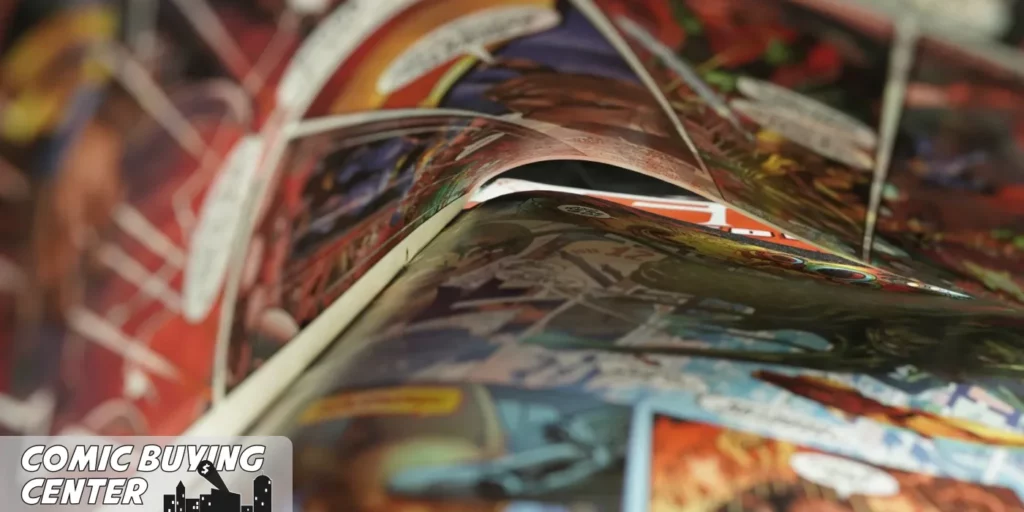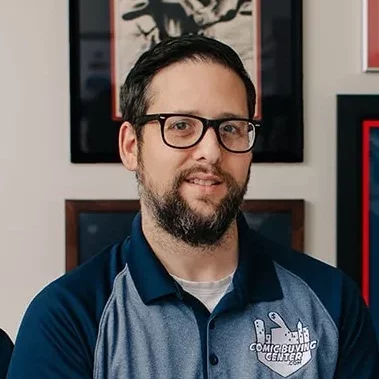Understanding comic book terms can be important if you’re fond of collecting them or want to be a part of the community. This glossary provides definitions of key comic book terms, helping new readers and seasoned fans to better understand those pesky and mysterious comic book words. It is also important for collectors and generally people who wish to sell comic books. But even if you’re not interested in professionally collecting comics you may find it useful to know some of the most popular terms. Just to understand what people around you are talking about in case you spend some time with the community, like to use special forums and so on.
Comic Book Parts and Terminology
Understanding comic book terminology and comic book anatomy is important for both casual readers and collectors. It helps readers fully understand the structure and storytelling techniques of comics. For collectors, especially those aiming to do it semi-professionally or professionally, this knowledge helps with assessing the value and condition of comic books. Familiarity with the terms used to describe various parts of a comic book, such as the cover, panels, and splash pages, allows collectors to make informed decisions and communicate effectively with others in the community. This understanding bridges the gap between simple enjoyment and serious collecting.
Cover
In comic book terms, the “cover” refers to the front exterior page of a comic book. It is designed to attract readers and often features the best artwork and the title of the comic. The cover serves as the first impression and can significantly influence a comic’s marketability and value. In the context of comic book anatomy, covers are sometimes referred to as “wraparound covers” if the artwork extends to the back, or “variant covers” when multiple versions are released. Collectors and readers often use these terms to describe and differentiate between editions, making cover knowledge relevant.
Spine
In comic book vocabulary, the “spine” refers to the edge of the comic book where all the pages are bound together. It is an important part of comic book anatomy as it typically contains information like the title, issue number, and publisher. The condition of the spine is important for collectors, as damage such as creases, splits, or fading can drastically decrease a comic book’s value. Sometimes, the term “square-bound” is used when the spine is more rigid, making it one of the graphic novel terms as they are usually thicker than regular comics.
Staples
“Staples” refer to the metal fasteners used to bind the pages of a comic book together along the spine. They are an important part of a comic book, as they basically keep an entire comic in one piece. Collectors pay close attention to the condition of the staples, as rust, missing staples, or loose pages can affect a comic book’s value. In some cases, you might hear terms like “single-staple” or “double-staple” binding, indicating how many staples were used. Understanding the role and condition of staples is important for accurately assessing a comic book’s overall condition.
Pages
“Pages” refer to the individual sheets of paper that make up the content of a comic book. Each page typically includes panels, artwork, and text that together tell the story. The quality and condition of the pages are of key importance to collectors, as issues like yellowing, tears, or stains can affect a comic book’s value. Some jargon terms related to pages include “splash page,” which is a single panel page often used for dramatic effect, and “double-page spread,” which is an image that spans two facing pages. Understanding the different types of pages and their condition matters in assessing the overall quality of a comic book.
Coupons
“Coupons” refer to small, removable sections within a comic book that readers could cut out and redeem for various offers, such as merchandise, special offers, or entry forms for contests. These coupons were a common feature in older comics. The presence or absence of coupons can impact the value of a comic book for collectors. A comic book with all its coupons intact is considered “complete,” while one with missing coupons is often termed “clipped” or “incomplete.”
Pack-Ins
“Pack-ins” refer to additional items included with a comic book, typically as promotional materials. These can include posters, trading cards, action figures, stickers, or other collectibles. Pack-ins are sometimes called “inserts” or “bonus items.” For collectors, the presence and condition of pack-ins can affect the comic book’s value. A comic book with all original pack-ins intact is often more valuable and desirable. Understanding the importance of pack-ins helps collectors ensure they have complete editions and accurately assess the overall value of their comics. Collectors often seek comics with original pack-ins to maintain the completeness and authenticity of their collection.
Creative Roles Within a Comic Book Creation
Creating a comic book is a long and difficult process. It includes many roles, each contributing to the final product. The writer crafts the story, developing the plot and dialogue. The penciler then draws the initial artwork, laying out the visual narrative. Inkers add depth and detail to the pencil drawings, adding shadows and contours. Colorists bring the pages to life with color, setting the tone and mood. Letterers are responsible for placing text, including dialogue, sound effects, and captions, ensuring readability and visual harmony. Finally, editors oversee the entire process, ensuring consistency, quality, and adherence to deadlines and standards. Each role is important, and their collaboration results in a cohesive and interesting comic book.

Comic Book Formats
There are many types of comic formats, each offering a unique reading experience. The primary comic book format includes single issues and average comic book length for them is around 20-40 pages and they are released monthly. Graphic novels are another type, compiling a complete story or collection of stories into a single volume. Trade paperbacks are similar but usually collect several consecutive issues of a comic series. Webcomics are digital comics published online, offering easy access to readers worldwide. What’s a comic strip, you might ask? It’s a short-form comic typically found in newspapers or online, featuring a brief, self-contained story or joke.
Comic Book Grading Terms
Comic book grading terms are used to assess the condition and value of comic books. These grades range from “Mint” (MT), which indicates a flawless copy, to “Poor” (PR), which indicates significant damage. Some common grades include:
- Mint (MT). A flawless copy with no visible damage.
- Near Mint (NM). Almost perfect with only minor imperfections.
- Very Fine (VF). Slight wear but still well-preserved.
- Fine (FN). Noticeable wear but still in good condition.
- Very Good (VG). Moderate wear with some defects.
- Good (GD). Significant wear but still readable.
- Fair (FR). Major defects but still complete.
- Poor (PR). Severe damage and possibly incomplete.
Understanding these grading terms helps collectors and sellers accurately describe and value their comic books.
Other Comic Book Terms
There are hundreds and hundreds of specific terms. Here are some terms you may find interesting:
- Splash Page. A full-page illustration, often used at the beginning of a comic, to grab the reader’s attention with a dramatic or important scene.
- Spread. An illustration that spans two facing pages, creating a larger and more impactful visual experience.
- Inker. The artist who improves the penciled drawings by adding depth, shading, and definition, typically using ink.
- Colorist. The artist responsible for adding color to the inked drawings, helping to set the mood and tone of the story.
- Letterer. The person who adds the text to the comic, including dialogue, sound effects, and captions, so that it integrates with the artwork.
Understanding comic books terms may be important in case you want to become part of this community.


